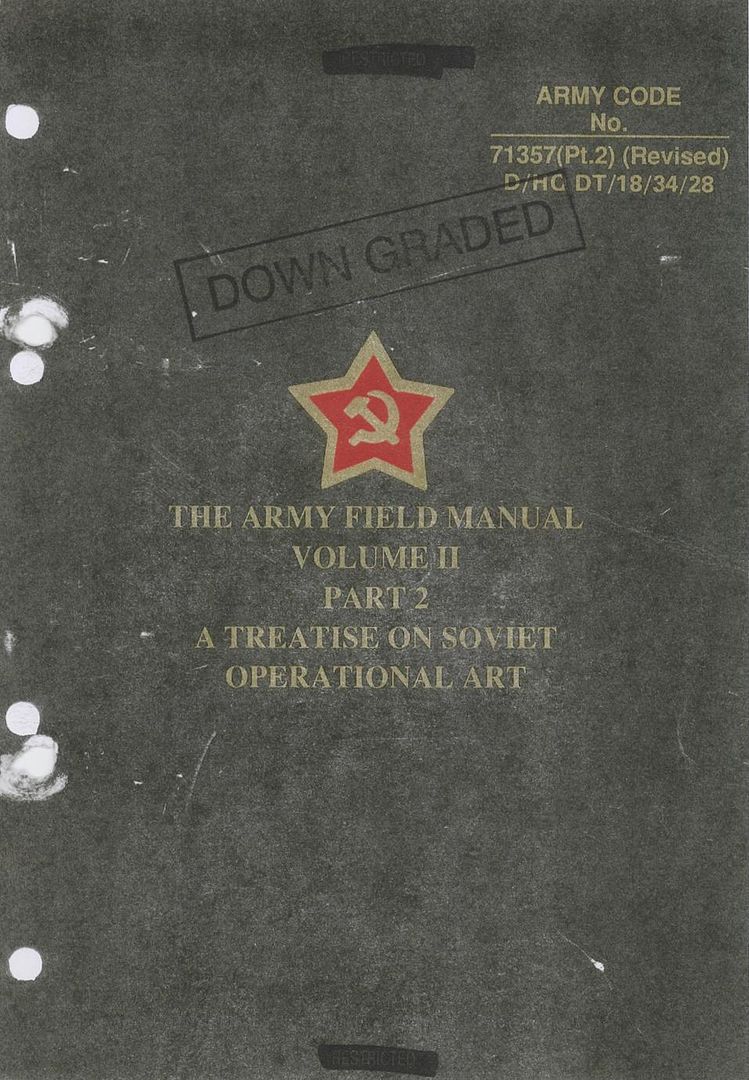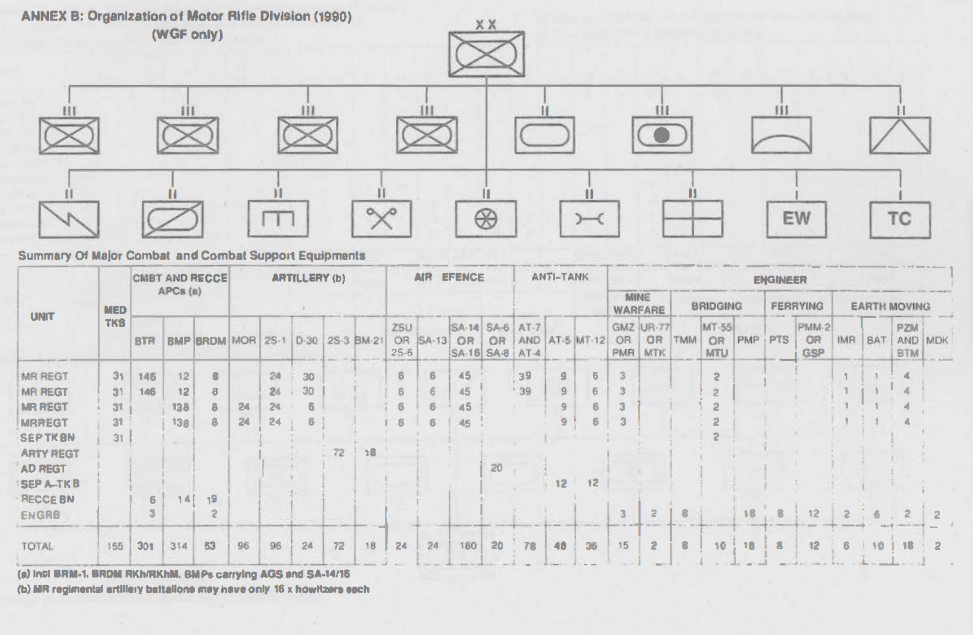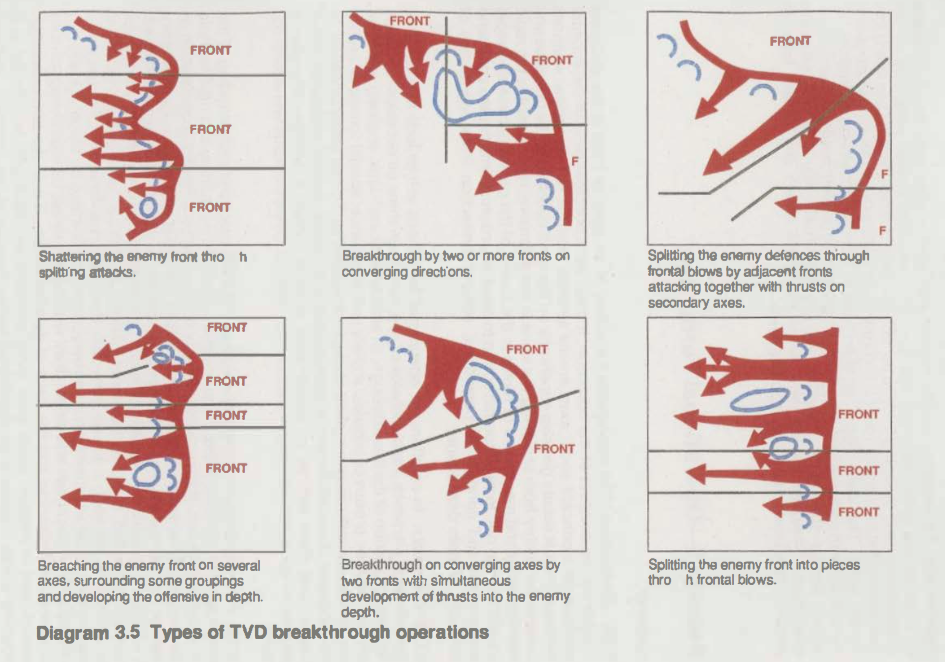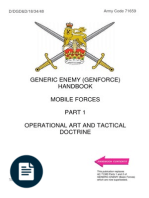This was a truly great find by Andy Miles who kindly posted it onto the Red Storm Rising facebook page. It's not quite the British equivalent to the FM 100 series, it was written in 1991 from the perspective of understanding Soviet Operational Art as the British along with most Western Nations had given this particular subject a stiff ignoring for most of the Cold War. As the author puts it, the Western Nations experience of operations during WW2 was at a different order of Magnitude to the Soviet and points out that whilst the Western allies deployed some 3 Army Groups comprising 91 Divisions on a front of 400 km, in 1944 the Red Army had 10 fronts with 57 Armies and over 560 Divisions and Corps deployed on a frontage of 3200 km.
AFM Volume 2 was produced in 3 parts and whilst this review focuses on Part 2, I will look to pick up on parts 1 and 3 at a later date, for completeness the parts are:
AFM Volume 2 was produced in 3 parts and whilst this review focuses on Part 2, I will look to pick up on parts 1 and 3 at a later date, for completeness the parts are:
- Part 1 is a Book entitled "Background to the Soviet Army 1986", Christopher Donnellys "Red Banner The Soviet Military System in Peace and War (1988)" is the updated version of Part 1
- AFM Volume 2, Part 2, A Treatise on Soviet Operational Art
- AFM Volume 2, Part 3, Soviet Tactics
So what's different between this and the FM 100 series, its based on a similar variety of sources including the Vorisilov Lectures, which it contextualises against a late 80s Force structure and is fundamentally focused on the conduct of operations at Army and Front level, and the general Force Composition and task orginisation required to deliver that. I think it does this well focusing on the Soviet Approaches to Offensive and Defensive Operations, it also provides a variety of commentary on effectiveness and some interesting discussion around both drivers for change and the future, which is where it differentiates itself from the FM 100 series.
Equipment and Organisation is considered at a high level and with only sufficient detail to facilitate the main discussion and demonstrate the mapping between doctrine technology and force structures, which frankly the Soviets were masters of.
It broadly follows the structure of the Vorisilov Lectures material and includes a deal of informed comment, the main chapters cover:
It broadly follows the structure of the Vorisilov Lectures material and includes a deal of informed comment, the main chapters cover:
- Equipment and Organisation
- Operational Planning, Context and Concepts
- Strategic and Operational Marches
- Offensive Operations
- Operations in the Enemys Depth
- Defensive Operations
- Combat Support
- Air Operations
- Amphibious Operations
- Logistics
- Command Control and Communications
Annexes include High level org charts and Broad equipment TOEs for Divisions, Armies and Fronts both within and outside of the Western Group of Forces
This is a book that you can either read or dip into, having said that the approach to dipping into it is likly to be go read the whole section on offensive opps and related elements on combat support. The Upside over reading the Vorisilov Lecture material is that the hard work of placing it in the context of the late 80s has been done and this work draws on wider material as well.
The author CJ Dick of the Soviet Studies Research Centre understands his subject well and attempts to explain the Soviet concepts as they stand rather than trying to equate Soviet military thought to western ideas, an approach taken in a number of the US manuals which generates some very confusing discussions on echelonment and reserves amoungst others. These subjects are covered with far more clarity in this volume.
I particularly like the categorisation of the Cold War period into a number of Eras based on the prevailing doctrine and the discussion around its impact on force structures and organisation. These are articulated as:
I particularly like the categorisation of the Cold War period into a number of Eras based on the prevailing doctrine and the discussion around its impact on force structures and organisation. These are articulated as:
- The Nuclear Era. Doctrine and force structures dominated by the concept of Combat under nuclear conditions
- The Era of a Conventional Phase. This period was dominated by the impact of two ideas. The first was driven by the NATO's adoption of flexible response, which would lead to a Conventional Phase at the start of any war and if surprise could be achieved and Soviet Operational art delivered offered the potential of a conventional victory. The other was the vulnerability of tank heavy formations in conventional war demonstrated during the 1973 Yom Kippur War.
- The Era of Conventional War. The result of the INF treaty and the failure by both the Warsaw Pact and NATO to upgrade their nuclear capabilities, lead to a belief in the increasing likelihood of an extended conventional phase or the possibility of a wholly conventional war
Looking at the diagrams and discussion it seems clear that this work fundamentally underpins The Genforce Mobile Force Handbooks written in 1997 as OPFOR guides which provide excellent commentary on what was essentially Soviet organisation and practice but which because they are OPFOR guides I have always had concerns over how they were adapted and how representative they were of what was rather than what was aspired to.
Some of the organisational structures proposed in both this and AFM volume 2 part 3, Soviet Tactics are quite different from what is discussed elsewhere and I have yet to digest what that means and how or whether to reflect it into my current projects.
Some of the organisational structures proposed in both this and AFM volume 2 part 3, Soviet Tactics are quite different from what is discussed elsewhere and I have yet to digest what that means and how or whether to reflect it into my current projects.
As well as this post I have updated the Post on free resources on Soviet Organisation and Doctrine. All up an excellent find, resource and for free well worth a read. I have a physical copy of the Vorisilov Lectures Operational Art and would love to find a physical copy of this to add to the collection but so far have looked without success. An excellent perspective on Soviet Operational Art
References:
Red Banner The Soviet Military System in Peace and War, C Donnelley, (1988) @ amazon
AFM Volume 2, Part 2, A Treatise on Soviet Operational Art
AFM Volume 2, Part 3, Soviet Tactics
Voroshilov Academy Lectures
Review-Web Resources, The Essentials of Cold War Soviet Doctrine and Organisation for Free
Genforce Handbook, Mobile Force Part 1, Operational Art and Tactical Doctrine, 1997
Genforce Handbook, Mobile Force Part 2, Tables of Organisation and Equipment, 1997
Other Book Reviews:
Rapid Fire Able Archer Rule Set
Review- Book, Today's Army Air Corps, P Beaver, 1987
The Race to the Swift
Soviet/Russian Armour and Artillery Design Practices
Modern African Wars (3) South West Africa
Red God of War, Soviet Artillery and Rocket Forces
Iron Division, The History of the 3rd Division 1809-1989
Jane's Armour and Artillery 2002/2003
Modern African Wars (3) South West Africa
Red God of War, Soviet Artillery and Rocket Forces
Iron Division, The History of the 3rd Division 1809-1989
Jane's Armour and Artillery 2002/2003




